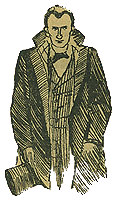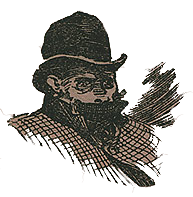SEXTON BLAKE AND ... WHO?
by Mark Hodder
If you were the world's greatest consulting detective, who would you prefer to have at your side in a crisis? Doctor John H. Watson perhaps? Certainly he's reliable and loyal ... but, well, he's not exactly dynamic, is he? And that mysteriously mobile war-wound will probably slow him down a bit. Or maybe you could borrow Archie Goodwin from Nero Wolfe? Tough as nails, yes, but he does have that dreadful habit of answering back. Could you live with all that sarcasm? No, what you need is a spirited, resourceful, skilled and loyal sidekick. Someone who will obey your orders without question but who will act on their own initiative when necessary. He needs to be a master of disguise, an expert tracker, an excellent driver and very handy with his fists. In other words ... you need Tinker.
Sexton Blake was lucky enough to find the ultimate sidekick. But he had to audition a few before the outstanding Edward 'Tinker' Carter arrived on the scene. And even when the "young'un" was well-established, the detective still occasionally employed an alternative deputy or two.
Here's a quick introduction to some of the people (and not just people) who fought at Blake's side:
Will Bastable
In 1905, William Stanhope Sprigg told UNION JACK readers about SEXTON BLAKE'S FIRST CASE. Our hero is just 18-years-old and working as a clerk in a lawyer's office. One night he discovers a woman in a black mask breaking into the office safe. During the adventure that follows, he is assisted by a fellow clerk, named Will Bastable. Like Blake, Bastable fancies himself as something of an amateur detective but his talents are nowhere near as well-developed. He spends much of the story in awe of his friend's ability to unravel the truth from the merest of clues. At the end of the escapade, the young Sexton Blake is rewarded for his efforts by being sponsored as a private investigator. His new business is named Blake & Co. and is established in offices in St. Martin's Lane, near Trafalgar Square ... and Will Bastable becomes Blake's very first assistant (chronologically-speaking, at least). Despite his lack of acuity, Will Bastable obviously possessed qualities which Sexton Blake admired, though from the story it's hard to tell what these might have been. The association doesn't appear to have lasted long; to my knowledge, Bastable was never mentioned again.
 Jules Gervais
Jules Gervais
The creator of Sexton Blake, Harry Blyth, introduced the detective in the 1893 story THE MISSING MILLIONAIRE. In it, Blake is desperate for a high-profile case to boost his finances and his reputation. Fortunately, a French detective named Jules Gervaise, who is older than Blake and well-established in his own country, refers a case to him. The Sexton Blake of the 1920s would have cleared the mystery up in a matter of hours without batting an eyelid ... but the 1893 Blake is a lot less experienced and blunders around rather ineptly before Gervaise turns up to help him. By the end of the story, the two men have gone into partnership and take offices together. Their association lasts for another couple of stories but then, in a tale about Gervais which doesn't feature Sexton Blake (THE ACCUSING SHADOW in HALFPENNY MARVEL issue 48), the more senior detective contemplates retirement. Apparently he took it, as he was never heard of again. Okay, so Gervais was never Blake's assistant (more the other way around, really) but he still deserves to be listed here as the two men worked side-by-side for some time.
We-wee
Sexton Blake's first boy assistant would probably prefer to remain nameless. Well, if you were called "We-wee," wouldn't you? The 9-year-old Chinese boy is first encountered in CHASED THROUGH CHINA by William Shaw Rae, published in 1897. Blake has been chained to a post by the villains of the story and is being tormented by vicious urchins. But one of them doesn't join the torture. Instead, he presses a key into the detective's hand, thus facilitating his escape. Later, Blake sees the boy being beaten by his evil guardian. He intervenes and ends up purchasing We-wee for a mere two sovereigns. He declares that the youngster is free but We-wee insists on staying at his side. And it's just as well that he does, for the boy plays a key role in the adventure which follows. Afterwards, We-wee returns to Britain with the detective and features in at least fourteen stories between 1897 and 1901. The Chinese lad is remarkably resourceful and often dominates the tales by instigating plot points, arranging crucial events and, occasionally, by providing the solution to whatever mystery is at hand. When studying a suspect, he is thorough in the extreme; noting their physiognomy, peculiarities of speech and gesture, personal traits and mannerisms. Despite his Oriental appearance, he is a master of disguise and effortlessly passes for a European. We-wee is easily Tinker's equal but he seems to possess a more independent streak, often acting where Tinker would await orders. From a literary point of view, this rather takes the limelight off Sexton Blake, which might be why We-wee didn't last. It's a shame because his adventures are thoroughly enjoyable and he makes an admirable sidekick. Bad name, though.
 Griff
Griff
By far the weirdest and most mysterious of Sexton Blake's assistants, Griff appeared in an 18-part serial, GRIFF THE MAN-TRACKER, which was written by Christopher Stevens (actually Julian Rochfort) and published in 1901. Griff's exact nature is never properly described but, from what we're told, it's highly likely that he's some sort of ape! Physically, he is wide and squat with long thick arms and short bandy legs. He always keeps his lower face covered by a scarf and his upper face in the shadow of the brim of a bowler hat. But in the space in between, his fierce eyes glow like 'fiery slits'. When outside, Griff wears a large coat and loose trousers. Inside, he prefers a smoking-cap, long red dressing gown, baggy trousers and vermillion slippers. He has to breathe through a respirator otherwise the damp English air will make him ill. Blake has dedicated much time to Griff's training and feeds him fruit which approximates that from his natural environment. As an assistant, Griff isn't exactly clever, usually acting on instinct if no orders are forthcoming. He's not as intelligent as Blake's later animal assistant — Pedro the bloodhound — but he's a lot stronger and more agile, leaping across rooftops, climbing sheer walls and running along the narrowest of walls. Uniformed policemen give him the jitters — which is a bit of a setback - but he also has some sort of sixth sense which enables him to distinguish good people from bad. So even though he may not know the reason why, Griff often does exactly the right thing at exactly the right time. After the final instalment of this serial, we never meet Griff again, so we can only guess that Sexton Blake came to the conclusion that an ape assistant wasn't ideal. Perhaps there were too many banana skins (or worse) left lying around the office.
Wallace Lorrimer
Wallace Lorrimer made just one appearance in the UNION JACK, in a story entitled SEXTON BLAKE'S LOST CLUE. This tale is a remarkable entry in the Blake saga because, in it, Blake is married, though we never find out to whom. The mysterious wife — and Lorrimer — were never mentioned again in the UJ but they do feature in two long serials in THE MARVEL. THE REAL ADVENTURES OF SEXTON BLAKE is a sequel to the UJ tale and THE KING OF DETECTIVES follows on straight after the first serial. In all these stories, Wallace Lorrimer is more of an apprentice than an assistant. He doesn't seem much younger than Blake and he is definitely training for an independent career as a detective. This nearly goes off the rails when he falls in love with and marries a girl named Mary Aylin, who doesn't want him to continue in such a dangerous business. During his recorded time with Blake, Lorrimer sweeps in and out of the long serials; sometimes playing the central role, other times disappearing for a number of instalments. In keeping with this unpredictability, his character is passionate and somewhat wayward; a little immature but obviously working hard to learn his trade. Interestingly, he isn't Blake's only assistant at this time: We-Wee makes an appearance during the serials, as does an office boy named Raffles.
Nipperty Chris
In 1898, right in the middle of the We-wee era, one story pops up with a different boy assistant at the detective's side. In 'TWIXT GALLOWS AND GOLD, Blake creator Harry Blyth informs us that: 'The speaker was "Nipperty Chris", the great detective's latest juvenile assistant, who, like some of his predecessors, had been rescued from gutter-life for his shrewdness. He was a broad, bright, snub-nosed little fellow, with short, yellow hair, growing so coarse and close that he would often facetiously declare that if all else failed he could let himself out as a broom.' Note the plural: 'predecessors'. Who, exactly, is Blyth referring to? Only We-wee fits the description, so who are the others? As for Nipperty, well here we have a full-blown Tinker prototype. In every way, the lad foreshadows Blake's archetypal helper; a fiercely loyal, cheeky cockney urchin whose 'street-smarts' prove invaluable. In fact, you could be forgiven for thinking that Nipperty Chris is Tinker but operating under, for some reason, a nom de plume.
Bathurst
From 1907 to 1913, the PENNY PICTORIAL ran short Sexton Blake tales covering the cases he dealt with during a time of supposed convalescence. We are not informed what ailment the detective was supposed to be recovering from, simply that Blake: '... ordered to rest by his doctors, had temporarily forsaken Baker Street, and was living during the period of these episodes in a quiet little house at Surbiton, amusing himself by flower culture, the cottage having been lent to him by an old friend, a Mr. Dove, a retired official from Scotland Yard, who was absent on the Continent.' Since the first of these stories was published three years into Tinker's reign as Assistant Extraordinaire, we can only assume that the young'un was holding the fort back in Baker Street while his master rested (not that there was much rest was involved). Filling his shoes by the detective's side, we have Bathurst. About the same age as Sexton Blake, and a member of the same 'Gentlemen's Club', Bathurst is a totally nondescript character. He fetches and carries and occasionally drives ... but his most important function is simply to listen as Blake explains who did what to whom, how they did it, and what they did it with. Bathurst is never described, doesn't talk much, and has little of the resourcefulness displayed by the other assistants. His contribution can be summed up in two words: 'plot device'. But, strangely enough, having read a few of the PENNY PICTORIAL stories, one can't help but become rather fond of Bathurst. A modest and unassuming old fellow, he has the same quality as Blake's threadbare dressing gown; nothing much to recommend it but nice to have around anyway. Perhaps that's the way Sexton Blake felt about him too.
These alternative sidekicks are a fascinating bunch but, given the opportunity, would any of them have become as popular and survived for so long as Tinker? Will Bastable and Bathurst; no, both too bland. Jules Gervaise; too superior (and too French). We-wee; perhaps, had his name been a little less silly. Griff; fascinating but too limited. Nipperty Chris; well, he simply transformed into Tinker anyway.
It looks like Sexton Blake made the right choice. But, then, he would, wouldn't he?
